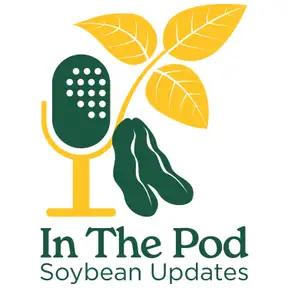06/12/25 Early Reflections on This Season’s Soybeans
You're listening to In The Pod, soybean updates, a weekly trek into the latest soybean information from NDSU Extension. This season's rain, wind, and varied temperatures are creating challenging conditions for soybean farmers. Here to update us is Ana Carcedo, NDSU Extension agronomist. Ana, how are the soybeans faring so far this season?
Ana Carcedo:I think this is a perfect moment to actually talk a little bit about soybeans because most of the soybeans are out of the ground right now. When we start thinking about this season, something that we we can remember is that this winter, we did not have as much snow cover as we used to. That was a little bit worrisome for most of farmers, but, thankfully, we got some moisture after. So April started really dry, but then it actually warmed up, and we have enough moisture to have some early planting date. So that was good. But then it cooled off. It warmed up. It cooled off. It warmed up. And after that, we have heavy rains that led to having some areas of the state, some fields with some fluid in problems that that's never nice. After that, we have crusting. So we can say we have quite a bit of problems with emergence, and that actually led to have some fields being replanted. And I got a few questions on how to use a rotary hoeing, so it's things that we are not that used to. And when we're talking about crafting, actually, especially important when we're talking about the Red River Valley because it's the area where there is more tillage in the state. And when we are talking about tillage, we're going to say, we do not have as much residues as we would like to. So the impact of the raindrops, the erodes our soils, and that's what is actually taking off of the structure of our soils, and that's why we have crossing problems later. Most of the state is in good moisture, so that's something that we can be a tiny bit relaxed for now. But I will really like to see some warmer temperatures.
Bruce Sundeen:What other weather conditions are impacting soybeans?
Ana Carcedo:We have a lot of strong winds, severe winds. And if you are in the Red River Valley area, you might have seen some dust storms also because of the tillage, and it's basically all our topsoil just going away. It's a call for awareness to start thinking and talking about soil health as well.
Bruce Sundeen:Ana, is there anything out of the ordinary going on this year?
Ana Carcedo:Another thing that was really curious about this season, it's the smoke. We have all the wildfires from Canada coming to our area. Something that actually concerned a few farmers that gave a few calls to me, and, basically, the answer is it's too early. It's too early for that smoke to be an actual concern for us right now. So we know smoke is basically preventing the radiation from the sun, and that's basically energy. That's the energy that our plants need to grow. And if we have just some clothes or smoke just covering, we just do not have that energy. Right now, the plants are too early to be an actual concern. If we were, like, closer to grain filling, then it might be something that we should be aware of.
Bruce Sundeen:Ana, when is it important to scout for nodules?
Ana Carcedo:When we're talking about V two, V three is the moment that you should be concerned about going and scouting your field for nodules. So we know that nitrogen fixation is something really important for soybeans. It covers 50% of the nitrogens that the soybeans take from our fields. So it's a huge number. It's really, really important. So go around V two, V three to check your nodules, check if you have good nodulation. It's great. If you don't have good nodulation, you might be one to consider some fertilization strategies just to try to patch that.
Bruce Sundeen:Thanks, Ana. Our guest has been Ana Carcedo, NDSU Extension agronomist. You're listening to In the Pod, soybean updates, a weekly trek into the latest soybean information from NDSU Extension supported by the North Dakota Soybean Council.

